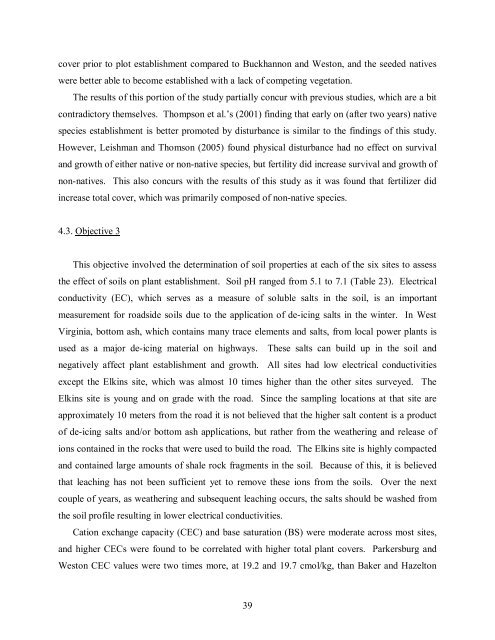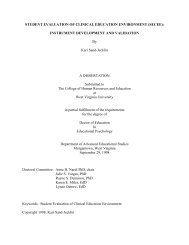The Use of Native Plants for Revegetation along West Virginia ...
The Use of Native Plants for Revegetation along West Virginia ...
The Use of Native Plants for Revegetation along West Virginia ...
You also want an ePaper? Increase the reach of your titles
YUMPU automatically turns print PDFs into web optimized ePapers that Google loves.
cover prior to plot establishment compared to Buckhannon and <strong>West</strong>on, and the seeded natives<br />
were better able to become established with a lack <strong>of</strong> competing vegetation.<br />
<strong>The</strong> results <strong>of</strong> this portion <strong>of</strong> the study partially concur with previous studies, which are a bit<br />
contradictory themselves. Thompson et al.’s (2001) finding that early on (after two years) native<br />
species establishment is better promoted by disturbance is similar to the findings <strong>of</strong> this study.<br />
However, Leishman and Thomson (2005) found physical disturbance had no effect on survival<br />
and growth <strong>of</strong> either native or non-native species, but fertility did increase survival and growth <strong>of</strong><br />
non-natives. This also concurs with the results <strong>of</strong> this study as it was found that fertilizer did<br />
increase total cover, which was primarily composed <strong>of</strong> non-native species.<br />
4.3. Objective 3<br />
This objective involved the determination <strong>of</strong> soil properties at each <strong>of</strong> the six sites to assess<br />
the effect <strong>of</strong> soils on plant establishment. Soil pH ranged from 5.1 to 7.1 (Table 23). Electrical<br />
conductivity (EC), which serves as a measure <strong>of</strong> soluble salts in the soil, is an important<br />
measurement <strong>for</strong> roadside soils due to the application <strong>of</strong> de-icing salts in the winter. In <strong>West</strong><br />
<strong>Virginia</strong>, bottom ash, which contains many trace elements and salts, from local power plants is<br />
used as a major de-icing material on highways. <strong>The</strong>se salts can build up in the soil and<br />
negatively affect plant establishment and growth. All sites had low electrical conductivities<br />
except the Elkins site, which was almost 10 times higher than the other sites surveyed. <strong>The</strong><br />
Elkins site is young and on grade with the road. Since the sampling locations at that site are<br />
approximately 10 meters from the road it is not believed that the higher salt content is a product<br />
<strong>of</strong> de-icing salts and/or bottom ash applications, but rather from the weathering and release <strong>of</strong><br />
ions contained in the rocks that were used to build the road. <strong>The</strong> Elkins site is highly compacted<br />
and contained large amounts <strong>of</strong> shale rock fragments in the soil. Because <strong>of</strong> this, it is believed<br />
that leaching has not been sufficient yet to remove these ions from the soils. Over the next<br />
couple <strong>of</strong> years, as weathering and subsequent leaching occurs, the salts should be washed from<br />
the soil pr<strong>of</strong>ile resulting in lower electrical conductivities.<br />
Cation exchange capacity (CEC) and base saturation (BS) were moderate across most sites,<br />
and higher CECs were found to be correlated with higher total plant covers. Parkersburg and<br />
<strong>West</strong>on CEC values were two times more, at 19.2 and 19.7 cmol/kg, than Baker and Hazelton<br />
39












